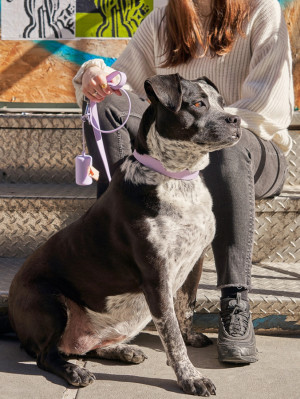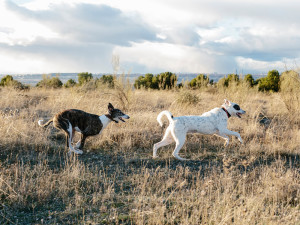Your Dog Takes Forever to Find a Place to Poop Because of This Scientific Phenomenon
Your pup is a compass, but only when they are doing their business.

Share Article
Earth’s magnetic field is essential for the survival of life on this planet. Without it, solar wind would blast our little blue dot with charged particles, stripping away our thin atmosphere and leaving our home as barren and lifeless as Mars. The magnetic field is not static, though. Rather, it is in a state of constant flux — its strength increasing and decreasing as it is bombarded by solar wind. This causes the magnetic north and south poles to shift throughout the day and even flip every 300,000 years or so.
According to NASAopens in new tab, the last flip was about 780,000 years ago, so another one could be imminent. If and when it happens, Earth’s magnetic field will weaken for a time, allowing more cosmic radiation to reach the planet’s surface. It’s also likely that multiple magnetic poles will pop up in unexpected locations across the planet, disrupting communication systems and power grids and causing problems for birds, whales, and other migratory animals that use the field to navigate. It could also really mess with your dog’s preferred pooping orientation.
Yes, the earth affects your dog’s bathroom habits.
That’s right: It turns out dogs are actually quite sensitive to shifts in Earth’s magnetic field and, when allowed to do so, will poop and pee with their bodies oriented along north-south magnetic field lines. This, according to a study published in Frontiers in Zoologyopens in new tab, in which Vlastimil Hart and his colleagues observed 70 dogs across 37 breeds over a two-year period as they did their business while on walks in an open field.
What they found was that when Earth’s magnetic field was calm and its shifts were mild, dogs would orient themselves along magnetic field lines. When the shifts were more extreme, however, they would abandon this behavior entirely.
How much do you spend on your pet per year?

“Typically, the daily declination [relative angle of magnetic field lines] comprises westward-shifts in the morning and eastward-shifts in the afternoon,” Hart writes. “While the magnetic field is rather stable at night. But magnetic storms, which disrupt the magnetic field, are common.
“Our analysis of the raw data indicates that dogs not only prefer north-to-south direction, but at the same time they also avoid east-to-west direction. The fact that larger and faster changes in magnetic conditions result in random distribution of body directions — i.e., a lowering of the preferences and ceasing of the avoidances — can be explained either through disturbing or conscious ‘shutdown’ of the magnetoreception mechanism.”
How do dogs even sense a magnetic field?
The evolutionary purpose of this magnetic field sensitivity is not entirely clear, but Hart and his team suspect it may allow dogs to better orient themselves the same way a human might take out a map and turn it and their body north to figure out where they are. This kind of calibration, however, only makes sense when the reference (aka the magnetic field) is stable. That’s why, when the magnetic field is active, dogs ignore it entirely, the same way you would ignore a compass if the needle was swinging back and forth.
Hart and his colleagues were not able to determine exactly how the dogs in the study perceived the magnetic field, though — only that they did so. Did they see it? Smell it? Hear it? Or was it more of a feeling of comfort versus discomfort, depending on how they oriented themselves? They couldn’t say.
The study did show that there was no discernible difference in sensitivity between male and female dogs, but Hart and his team were unable to say one way or the other if there were differences across breeds, due to the study’s small sample size.
“That makes sense,” says Jessica Jacobson, a New York-based dog behavior expert and celebrity dog trainer at Dapper Dog Trainingopens in new tab, who was not involved in the study. “I’ve never noticed a difference in pooping and peeing behaviors across gender or breed, either.”
Apparently, your dog’s age has something to do with this superpower of sorts.
Jacobson has noticed differences based on a dog’s age, as did Hart and his team, who found that pups between the ages of two and a half and seven were most likely to exhibit magnetic field sensitivity. Hart couldn’t say why, but the finding makes sense to Jacobson.
“The younger a dog is, the less tuned in it may be to its preferences,” she says. “It can also take time for a dog to realize what makes them most comfortable. At the same time, it makes sense that when dogs are older, they may view pooping and peeing more as just necessary bodily functions and be less concerned with the finer details.”
So, does this mean you should only take your dog out to poop and pee when the magnetic field is calm? “Definitely not,” Jacobson says. “A dog’s need to go to the bathroom is more urgent than their desire to orient themselves a certain way when they do, and, like the article says, they will go to the bathroom either way.”
There are, however, things you can do to make your pup’s potty time more comfortable. “As the study mentions, being off-leash allows the dog the most freedom to do what they want, how they want,” Jacobson says. “But that can be difficult in a city environment.” In that case, Jacobson advises that you try to leave some slack on the leash and follow your pup where they want to go without adding tension.
“Magnetism aside, most dogs prefer to be away from people when pooping and many dogs exhibit preferences for certain surface textures,” says Jacobson. “So, try to let them take you where they want to go.” And if you notice them deliberately orienting themselves north-to-south, at least you’ll know why and that Earth’s magnetic field is calm and stable. For now.

Charles Manning
Charles Manning is an actor and writer based in New York City. In his free time he likes to cook, go swimming at the public pool, volunteer at the LGBTQ senior center, and foster senior and special-needs cats. His work has previously appeared in Cosmopolitan, Elle, Marie Claire, Harper’s Bazaar, Seventeen, and Nylon.
Related articles
![Backview of a man in a dark grey suit with a leash and an attached poop bad holder that is attached to a greyhound dog in a grey sweater]()
9 Poop-Bag Holders That Will Save You in Any Dog Walk Emergency
When sh*t happens, you don’t have to be the one standing on the sidewalk without a plan.
![A black dog with a tilted head looks attentively at the camera while sitting in grass.]()
Is My Dog’s Poop Normal?
From bloody poop to diarrhea—all your dog’s poop problems explained.
![feeding black dog rice water to help relieve diarrhea]()
Vet-Approved Diarrhea Treatments
Shudder. It happens to all of us.
![Two dog chasing each other playfully in a prairie field outside]()
Don’t Worry, But Dogs Can Get Cancer From Sniffing Other Dogs’ Nether-Regions
The gnarly scoop on canine transmissible venereal tumors.
![Veterinarian examining a dog]()
My Dog Has Diarrhea. Should I Call the Vet?
Certain symptoms could mean your dog is battling a potentially fatal condition called hemorrhagic gastroenteritis (HGE). Here’s everything you need to know.






